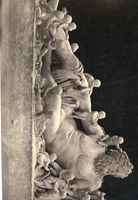Please use this identifier to cite or link to this item:
http://hdl.handle.net/20.500.14008/75479| DC Field | Value | |
|---|---|---|
| dc.date.accessioned | 2022-01-22T02:23:02Z | |
| dc.date.available | 2022-01-22T02:23:02Z | |
| dc.date.end | 299 | |
| dc.date.start | 100 | |
| dc.identifier.uri | http://hdl.handle.net/20.500.14008/75479 | |
| dc.description | <p>Colossal statue of the Nile, probably part of the decoration of the Iseo Campense. The river is represented as an old man laying on his side with a cornucopia of fruit on his left. Egypt is represented by the sphinx and some exotic animals. All around the body, sixteen children allude to the sixteen cubits of water by which the Nile rises for its annual flood. The base is decorated with pygmies, hippopotamus and crocodiles. The statue was found in 1513 in Campo Marzio where it was probably part of the decoration of the Iseo Campense, dedicated to the Egyptian deities Isis and Serapis.</p> | |
| dc.format.medium | marble (rock) | |
| dc.language.iso | zxx | |
| dc.source | https://cmc.byzart.eu/items/show/128758/ | |
| dc.title | Nile | |
| dc.type | image | |
| dc.type.materialandtechnique | sculpting | |
| dc.type.physical | statues | |
| dc.rights.license | http://creativecommons.org/licenses/by/4.0/ | |
| dc.relation.fond | UNIBO Europeana Archaeology | |
| dc.coverage.temporalperiod | Imperial/Late Roman | |
| dc.contributor.provider | AMSHistorica - University of Bologna | |
| dc.contributor.intermediateprovider | BYZART Project | |
| dc.contributor.dataprovider | University of Bologna | |
| dc.relation.place | Vatican Museums, Vatican City | |
| dc.type.magbiblevel | m | |
| dc.relation.project | BYZART Project | |
| dc.type.coar | Resource Types::image::still image | |
| item.treefondsroot | BYZART. Byzantine art and archaeology | |
| item.grantfulltext | open | |
| item.fulltext | With Fulltext | |
| item.cerifentitytype | Products | |
| item.coartype | still image | |
| item.openairecristype | http://purl.org/coar/resource_type/c_c513 | |
| item.openairetype | image | |
| Appears in Collections: | BYZART | |
Items in DSpace are protected by copyright, with all rights reserved, unless otherwise indicated.
 English
English
 Italian
Italian

